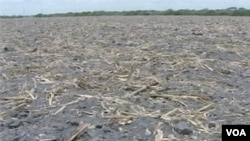This is the VOA Special English Agriculture Report.
America is the world’s largest food exporter. But the worst drought in half a century is hitting corn and wheat harvests. The drought across the central United States adds to concerns about world food supplies and prices in the coming years.
Experts say by twenty-fifty, the world will have to produce at least sixty percent more food to feed a population growing bigger and richer. China, a major food importer, is looking to producers around the world to guarantee future food supplies.
China has invested in food production in Australia and New Zealand. A new source of supply is Ukraine. Ukraine was known as the breadbasket of Europe because of rich corn and wheat harvests a century ago.
(SOUND)
Galyna Kovtok is chief executive of Ukraine’s largest agricultural business, ULF. She predicts that within a few months her company will be approved to export corn to China. That will make Ukraine the first country outside the Americas to do so.
ULF will soon have almost two million tons of elevator storage capacity as it prepares for the Chinese market. Chinese money is financing the building of six grain elevators. But the company's equipment is largely American, including half-million-dollar John Deere combines to harvest wheat.
ULF's grain production per hectare is now halfway between Ukrainian averages and the high yields of the American Midwest. But farming depends on the weather. Across the Black Sea region -- in Ukraine, Russia and Kazakhstan -- drought this year is pushing harvests down by fifteen to twenty percent.
Traditionally, the Black Sea region is the main source of wheat for North Africa and the Middle East. But this year, on the supply side, Russia may have to suspend exports. And, on the demand side, Africa and the Middle East are now competing with China.
At the same time, a new report says large parts of Asia may face long periods of severe drought within ten years. The report is from the British-based Center for Low Carbon Futures, a network of universities. It says northern China, India, Afghanistan, Mongolia and Pakistan will be especially hard hit. It says other parts of Asia are likely to face longer and wetter monsoon seasons because of climate change.
Andrew McConville works for the agricultural technology company Syngenta. He says a lack of new investment in technology to help farmers improve productivity has had an effect.
ANDREW McCONVILLE: "You really start to see, if you like, all of those things come together, laid over the top of very high prices as well, so you almost had a perfect storm of factors coming together.”
And that's the VOA Special English Agriculture Report. I'm Karen Leggett.
___
Contributing: James Brooke and Ron Corben
America is the world’s largest food exporter. But the worst drought in half a century is hitting corn and wheat harvests. The drought across the central United States adds to concerns about world food supplies and prices in the coming years.
Experts say by twenty-fifty, the world will have to produce at least sixty percent more food to feed a population growing bigger and richer. China, a major food importer, is looking to producers around the world to guarantee future food supplies.
China has invested in food production in Australia and New Zealand. A new source of supply is Ukraine. Ukraine was known as the breadbasket of Europe because of rich corn and wheat harvests a century ago.
(SOUND)
Galyna Kovtok is chief executive of Ukraine’s largest agricultural business, ULF. She predicts that within a few months her company will be approved to export corn to China. That will make Ukraine the first country outside the Americas to do so.
ULF will soon have almost two million tons of elevator storage capacity as it prepares for the Chinese market. Chinese money is financing the building of six grain elevators. But the company's equipment is largely American, including half-million-dollar John Deere combines to harvest wheat.
ULF's grain production per hectare is now halfway between Ukrainian averages and the high yields of the American Midwest. But farming depends on the weather. Across the Black Sea region -- in Ukraine, Russia and Kazakhstan -- drought this year is pushing harvests down by fifteen to twenty percent.
Traditionally, the Black Sea region is the main source of wheat for North Africa and the Middle East. But this year, on the supply side, Russia may have to suspend exports. And, on the demand side, Africa and the Middle East are now competing with China.
At the same time, a new report says large parts of Asia may face long periods of severe drought within ten years. The report is from the British-based Center for Low Carbon Futures, a network of universities. It says northern China, India, Afghanistan, Mongolia and Pakistan will be especially hard hit. It says other parts of Asia are likely to face longer and wetter monsoon seasons because of climate change.
Andrew McConville works for the agricultural technology company Syngenta. He says a lack of new investment in technology to help farmers improve productivity has had an effect.
ANDREW McCONVILLE: "You really start to see, if you like, all of those things come together, laid over the top of very high prices as well, so you almost had a perfect storm of factors coming together.”
And that's the VOA Special English Agriculture Report. I'm Karen Leggett.
___
Contributing: James Brooke and Ron Corben




